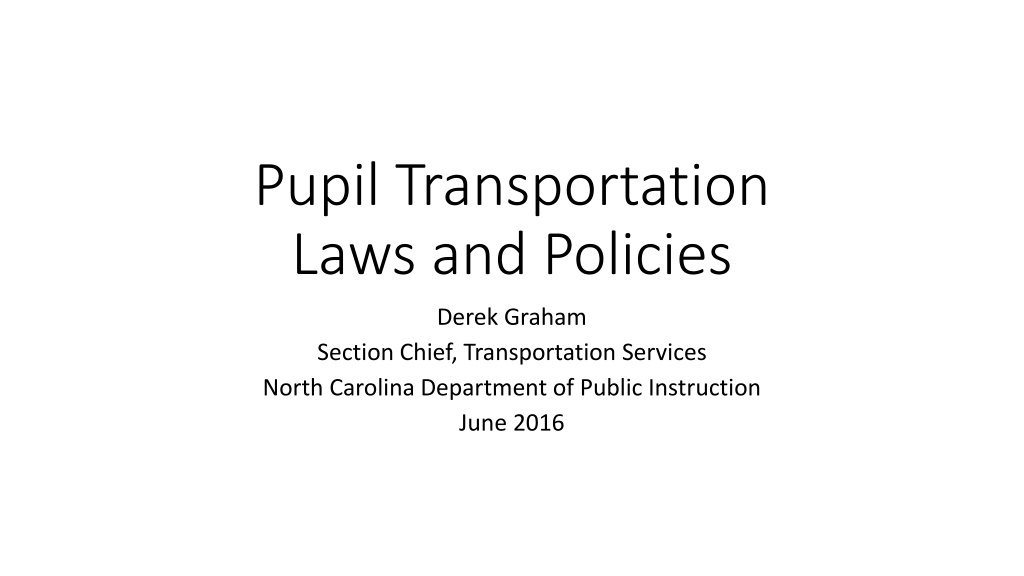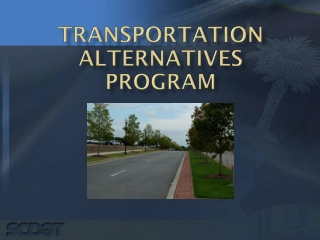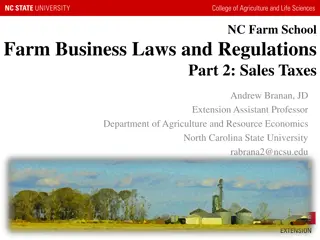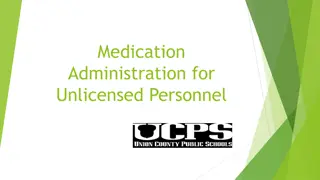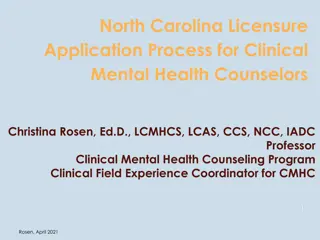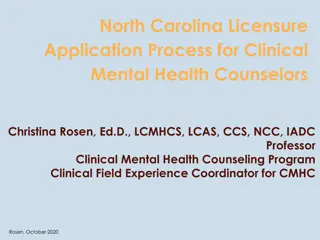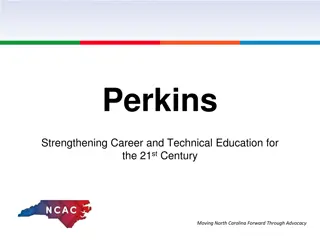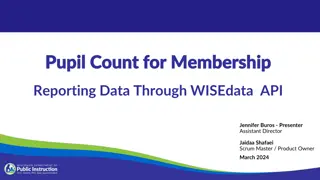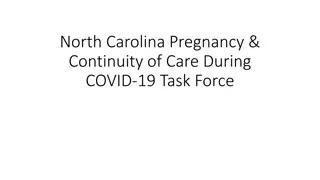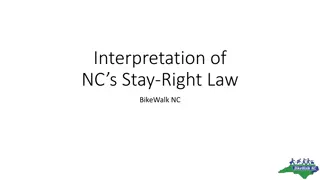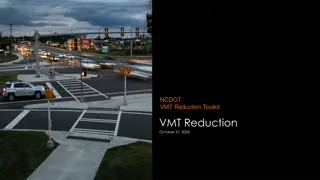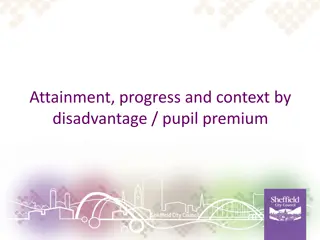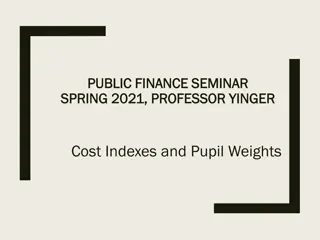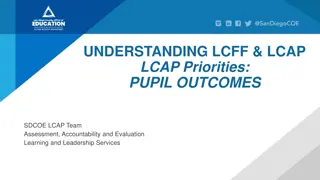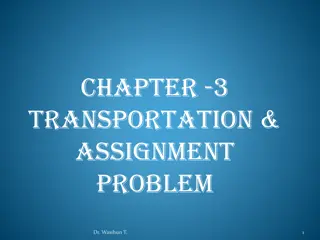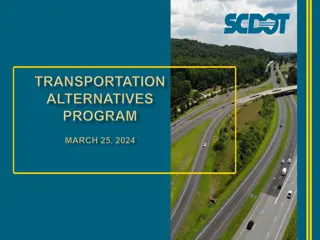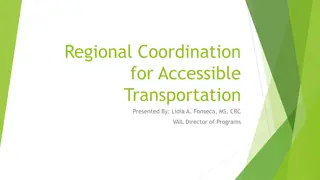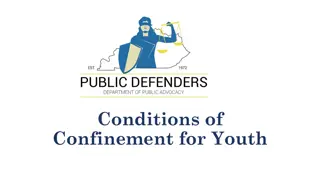Overview of Pupil Transportation Laws and Policies in North Carolina
Explore the comprehensive guide to pupil transportation laws and policies in North Carolina. Topics covered include state public school law, authority of local boards of education, duties of the State Board, guidelines for routing, assignment of school buses, and use and operation of school buses. Get insights into regulations, obligations, funding allocation, and operational guidelines governing pupil transportation.
Download Presentation

Please find below an Image/Link to download the presentation.
The content on the website is provided AS IS for your information and personal use only. It may not be sold, licensed, or shared on other websites without obtaining consent from the author. Download presentation by click this link. If you encounter any issues during the download, it is possible that the publisher has removed the file from their server.
E N D
Presentation Transcript
Pupil Transportation Laws and Policies Derek Graham Section Chief, Transportation Services North Carolina Department of Public Instruction June 2016
Various Components of Law State Public School Law Transportation State Public School Law - Other Motor Vehicle Law State Board of Education Policy Criminal Law Administrative Law Federal Law
State Public School Law Transportation G.S. 115C - 240-262
Public School Laws governing pupil transportation General Statutes, Chapter 115C Applies to LEAs Not to private schools Not to charter schools
115C 115C- -239 239. Authority of local boards of education. Authority of local boards of education. LEA can acquire and operate school buses
115C 115C- -240 Education Education 240. Authority and duties of State Board of Authority and duties of State Board of Promulgate rules and regulations No obligation to provide transportation Rules and regulations re: construction, capacity, No school bus shall be operated for the transportation of pupils unless such bus is constructed and maintained as prescribed in such regulations Guidelines for routing; TIMS (or equivalent by 1992) Allocate funds to LEAs LEAs use funds for buses and operations
115C 115C- -241. Assignment of school buses to schools 241. Assignment of school buses to schools Superintendent assigns the buses to be operated at each school
115C 115C- -242. 242. Use and operation of school buses Use and operation of school buses. Only for students enrolled and employees Limited to To and From school for the regularly organized school day Head Start facilities owned and operated by LEA Private school if LEA places student there One day prior to opening of school Not required for students living within 1.5 miles To serve the instructional purposes of the school Emergency management uses instate or local emergency (and testing plans at local expense)
115C 115C- -244. 244. Assignment of pupils to school buses Assignment of pupils to school buses. Responsibility of superintendent Any pupil may apply for transportation for the regularly organized school day Appeal is to the local board of eduction
115C-245. School bus drivers; monitors; safety assistants LEA shall employ drivers Driver has authority over bus; discipline No one can ride unless authorized by the Superintendent (or designee) Monitors unpaid volunteers to help with discipline May employ Transportation Safety Assistants (TSAs)
115C-246. School bus routes Superintendent, or designee, responsible for school bus routes (b) Unless road or other conditions make it inadvisable, public school buses shall be routed on state-maintained highways, municipal streets, or other streets with publicly dedicated right-of-way. The local board of education shall not be responsible for damage to the roadway. Each public school bus shall be routed so that the bus passes within one mile of the residence of each pupil assigned to that bus. A pupil who lives one and one-half miles or more from the school to which the pupil is assigned shall be eligible for school bus transportation. All routes filed at LEA and changes documented within 10 days
115C-247. Purchase of activity buses by local boards Authorized to operated activity buses to and from athletic events and for other local school activity purposes Local board shall adopt a policy for proper use of the vehicles. The policy shall permit use for athletic events during the regular season and playoffs and to other school-sponsored activities
115C-248. Inspection of school buses and activity buses; report of defects by drivers; discontinuing use until defects remedied. Superintendent shall cause each bus to be inspected every 30 days; findings documented and filed Driver must report defects promptly Principal or superintendent must remove from service if not safe Same applies to Activity Buses
115C-249. Purchase and maintenance of school buses, materials and supplies. LEA may purchase additional school buses Tax-levying authorities authorized to make provision in capital budget Funds appropriated by G.A. shall be allocated to LEAs School bus 20 years or 250,000 miles Under 15 years, 300,000 miles May receive $2000 in lieu of replacement that year Title to the LEA
115C-249. Purchase and maintenance of school buses, materials and supplies. LEA supplies buildings and equipment for storage and maintenance of buses Damage or destruction LEA may apply to the state for funds Buses and service vehicles purchased through Dept. of Administration Appropriations shall not revert
115C-249.1 Purchase of tires for school buses; repair or refurbishment of tires for school buses. LEA must purchase tires that posees the original ualtered and uncovered tire sidewall.
115C-253. Contracts for transportation. LEA may contract for transportation of pupils Vehicles constructed as required by the State Board Vehicles under 16 passengers don t have to meet school bus equipment requirements but rules adopted by State Board of Education
12-15 Passenger Vans http://www.ncbussafety.org/vans
115C-254. Use of school buses by State militia or national guard North Carolina State Defense Militia or the national guard to transport their members Expenses paid by the Militia or the guard
115C-255. Liability insurance and waiver of immunity as to certain acts of bus drivers. Ref 115C-42 except when operated with funds from State Public School Fund; waived governmental immunity by purchasing insurance (local vehicles)
115C 256-262 115C-256. School bus drivers under Workers' Compensation Act. 115C-257. Attorney General to pay claims Medical up to $3000 for pupils injured 115C-258. Provisions regarding payment Regardless of liability of driver 115C-259. Claims must be filed within one year 115C-262. Liability insurance and tort liability
115C-105.41 Students At-Risk of Academic Failure Local school administrative units shall identify students who have been placed at risk for academic failure . At the beginning of the school year, a personal education plan for academic improvement with focused intervention and performance benchmarks shall be developed for any student not performing at least at grade level Focused intervention and accelerated activities ..may include coaching, mentoring, tutoring, summer school, Saturday school, and extended days. Local school administrative units shall provide these activities free of charge to students. Local school administrative units shall also provide transportation free of charge to all students for whom transportation is necessary for participation in these activities.
20 20- -4.01. Definitions 4.01. Definitions d3. School activity bus. - A vehicle, generally painted a different color from a school bus, whose primary purpose is to transport school students and others to or from a place for participation in an event other than regular classroom work. The term includes a public, private, or parochial vehicle that meets this description. d4. School bus. - A vehicle whose primary purpose is to transport school students over an established route to and from school for the regularly scheduled school day, that is equipped with alternately flashing red lights on the front and rear and a mechanical stop signal, that is painted primarily yellow below the roofline and that bears the plainly visible words "School Bus" on the front and rear. The term includes a public, private, or parochial vehicle that meets this description.
G.S. 20-7 Drivers License Duration and Renewal of Licenses. - Drivers licenses shall be issued and renewed pursuant to the provisions of this subsection: (1) Duration of license for persons under age 18. - A full provisional license issued to a person under the age of 18 expires on the person's twenty-first birthday. (2) Duration of original license for persons at least 18 years of age or older. - A drivers license issued to a person at least 18 years old but less than 66 years old expires on the birthday of the licensee in the eighth year after issuance. A drivers license issued to a person at least 66 years old expires on the birthday of the licensee in the fifth year after issuance. A commercial drivers license expires on the birthday of the licensee in the fifth year after issuance. A commercial drivers license that has a vehicles carrying passengers (P) and school bus (S) endorsement issued pursuant to G.S. 20-37.16 expires on the birthday of the licensee in the third year after issuance, if the licensee is certified to drive a school bus in North Carolina.
G.S. 20-17 License Revocation 20-17. Mandatory revocation of license by Division. (a) The Division shall forthwith revoke the license of any driver upon receiving a record of the driver's conviction for any of the following offenses: (14) A conviction of driving a school bus, school activity bus, or child care vehicle after consuming alcohol under G.S. 20-138.2B.
20-130.1. Use of red or blue lights on vehicles prohibited; exceptions. (a) red light in or on any vehicle in this State. As used in this subsection, unless the context requires otherwise, "red light" means an operable red light not sealed in the manufacturer's original package which: (i) is designed for use by an emergency vehicle or is similar in appearance to a red light designed for use by an emergency vehicle; and (ii) can be operated by use of the vehicle's battery, vehicle's electrical system, or a dry cell battery. As used in this subsection, the term "red light" shall also mean any red light installed on a vehicle after initial manufacture of the vehicle. (b) The provisions of subsection (a) of this section do not apply to the following: (7) A school bus. It is unlawful for any person to install or activate or operate a
20 20- -137.4 137.4 Unlawful use of a mobile phone. (4) School bus. As defined in G.S. 20-4.01(27)d4. The term also includes any school activity bus as defined in G.S. 20-4.01(27)d3. and any vehicle transporting public, private, or parochial school students for compensation. (b) Offense. Except as otherwise provided in this section, no person shall operate a school bus on a public street or highway or public vehicular area while using a mobile telephone or any additional technology associated with a mobile telephone while the school bus is in motion. This prohibition shall not apply to the use of a mobile telephone or additional technology associated with a mobile telephone in a stationary school bus. (d) Exceptions. The provisions of subsection (b) of this section shall not apply to the use of a mobile telephone or additional technology associated with a mobile telephone for the sole purpose of communicating in an emergency situation.
G.S. 20 G.S. 20- -142.3 railroad grade crossings 142.3 Certain vehicles must stop at (a) vehicle carrying passengers for compensation, any commercial motor vehicle listed in 49 C.F.R. 392.10, and any motor vehicle with a capacity of 16 or more persons shall stop the vehicle within 50 feet but not less than 15 feet from the nearest rail of the railroad. While stopped, the driver shall listen and look in both directions along the track for any approaching train and shall not proceed until the driver can do so safely. Upon proceeding, the driver of the vehicle shall cross the track in a gear that allows the driver to cross the track without changing gears and the driver shall not change gears while crossing the track or tracks. Before crossing at grade any track or tracks of a railroad, the driver of any school bus, any activity bus, any motor (b) stop: Except for school buses and activity buses, the provisions of this section shall not require the driver of a vehicle to (1) At railroad tracks used exclusively for industrial switching purposes within a business district. (2) At a railroad grade crossing which a police officer or crossing flagman directs traffic to proceed. (3) approach of a train. At a railroad grade crossing protected by a gate or flashing signal designed to stop traffic upon the approach of a train, when the gate or flashing signal does not indicate the (4) At an abandoned railroad grade crossing which is marked with a sign indicating that the rail line is abandoned. (5) At an industrial or spur line railroad grade crossing marked with a sign reading "Exempt" erected by or with the consent of the appropriate State or local authority. (c) section shall not constitute negligence per se. A person violating the provisions of this section shall be guilty of an infraction and punished in accordance with G.S. 20-176. Violation of this (d),(e) Repealed by Session Laws 2001-487, s. 50(g). (f) be guilty of an infraction. Such employer will also be subject to a civil penalty under G.S. 20-37.21. (1991, c. 368, s. 1; 1999-274, ss. 1, 2; 2001-487, s. 50(g); 2005-349, s. 14.) An employer who knowingly allows, requires, permits, or otherwise authorizes a driver of a commercial motor vehicle to violate this section shall
20-217. Motor vehicles to stop for properly marked and designated school buses in certain instances; evidence of identity of driver.
20 20- -217. Motor vehicles to stop for properly marked 217. Motor vehicles to stop for properly marked and designated school buses in certain instances; and designated school buses in certain instances; evidence of identity of driver. evidence of identity of driver. Drivers must stop: (a)The driver of any vehicle upon approaching from any direction on the same street, highway, or public vehicular area any school bus (including privately owned buses transporting children and school buses transporting senior citizens under G.S. 115C-243), while the bus is displaying its mechanical stop signal or flashing red stoplights, and is stopped for the purpose of receiving or discharging passengers, shall bring the vehicle to a full stop before passing or attempting to pass the bus, and shall remain stopped until the mechanical stop signal has been withdrawn, the flashing red stoplights have been turned off, and the bus has moved on. Oncoming traffic does not always have to stop If oncoming traffic doesn t stop, a stop must be a right side pickup
(a) and the bus is stopped for the purpose of receiving or discharging passengers, the driver of any other vehicle that approaches the school bus from any direction on the same street, highway, or public vehicular area shall bring that other vehicle to a full stop and shall remain stopped. The driver of the other vehicle shall not proceed to move, pass, or attempt to pass the school bus until after the mechanical stop signal has been withdrawn, the flashing red stoplights have been turned off, and the bus has started to move. (b) For the purpose of this section, a school bus includes a public school bus transporting children or school personnel, a public school bus transporting senior citizens under G.S. 115C-243, or a privately owned bus transporting children. This section applies only in the event the school bus bears upon the front and rear a plainly visible sign containing the words "school bus." When a school bus is displaying its mechanical stop signal or flashing red lights
(c) vehicle traveling in the opposite direction from the school bus, upon any road, highway or city street that has been divided into two roadways, so constructed as to separate vehicular traffic between the two roadways by an intervening space (including a center lane for left turns if the roadway consists of at least four more lanes) or by a physical barrier, need not stop upon meeting and passing any school bus that has stopped in the roadway across the dividing space or physical barrier. Notwithstanding subsection (a) of this section, the driver of a
(d) discharge passengers or for any principal or superintendent of any school, routing a school bus, to authorize the driver of any school bus to stop and receive or discharge passengers upon any roadway described by subsection (c) of this section where passengers would be required to cross the roadway to reach their destination or to board the bus; provided, that passengers may be discharged or received at points where pedestrians and vehicular traffic are controlled by adequate stop-and-go traffic signals. It shall be unlawful for any school bus driver to stop and receive or
(e) violating this section shall be guilty of a Class 1 misdemeanor and shall pay a minimum fine of five hundred dollars ($500.00). A person who violates subsection (a) of this section shall not receive a prayer for judgment continued under any circumstances. (g) Any person who willfully violates subsection (a) of this section and strikes any person shall be guilty of a Class I felony and shall pay a minimum fine of one thousand two hundred fifty dollars ($1,250). Any person who willfully violates subsection (a) of this section and strikes any person, resulting in the death of that person, shall be guilty of a Class H felony and shall pay a minimum fine of two thousand five hundred dollars ($2,500). Except as provided in subsection (g) of this section, any person
(g1) person convicted of a second misdemeanor violation under this section within a three-year period. The Division shall revoke, for a period of two years, the drivers license of a person convicted of a Class I felony violation under this section. The Division shall revoke, for a period of three years, the drivers license of a person convicted of a Class H felony violation under this section. The Division shall permanently revoke the drivers license of (i) a person convicted of a second felony violation under this section within any period of time and (ii) a person convicted of a third misdemeanor violation under this section within any period of time. The Division shall revoke, for a period of one year, the drivers license of a
In the case of a first felony conviction under this section, the licensee may apply to the sentencing court for a limited driving privilege after a period of six months of revocation, provided the person's drivers license has not also been revoked or suspended under any other provision of law. A limited driving privilege issued under this subsection shall be valid for the period of revocation remaining in the same manner and under the terms and conditions prescribed in G.S. 20-16.1(b). If the person's drivers license is revoked or suspended under any other statute, the limited driving privilege issued pursuant to this subsection is invalid.
In the case of a permanent revocation of a person's drivers license for committing a third misdemeanor violation under this section within any period of time, the person may apply for a drivers license after two years. The Division may, with or without a hearing, issue a new drivers license upon satisfactory proof that the former licensee has not been convicted of a moving violation under this Chapter or the laws of another state. The Division may impose any restrictions or conditions on the new drivers license that the Division considers appropriate. Any conditions or restrictions imposed by the Division shall not exceed two years. In the case of a permanent revocation of a person's drivers license for committing a second Class I felony violation under this section within any period of time, the person may apply for a drivers license after three years. The Division may, with or without a hearing, issue a new drivers license upon satisfactory proof that the former licensee has not been convicted of a moving violation under this Chapter or the laws of another state. The Division may impose any restrictions or conditions on the new drivers license that the Division considers appropriate. Any conditions or restrictions imposed by the Division shall not exceed three years.
Any person whose drivers license is revoked under this section is disqualified pursuant to G.S. 20-17.4 from driving a commercial motor vehicle for the period of time in which the person's drivers license remains revoked under this section. (g2) Pursuant to G.S. 20-54, failure of a person to pay any fine or costs imposed pursuant to this section shall result in the Division withholding the registration renewal of a motor vehicle registered in that person's name. The clerk of superior court in the county in which the case was disposed shall notify the Division of any person who fails to pay a fine or costs imposed pursuant to this section within 20 days of the date specified in the court's judgment, as required by G.S. 20- 24.2(a)(2). The Division shall continue to withhold the registration renewal of a motor vehicle until the clerk of superior court notifies the Division that the person has satisfied the conditions of G.S. 20-24.1(b) applicable to the person's case. The provisions of this subsection shall be in addition to any other actions the Division may take to enforce the payment of any fine imposed pursuant to this section.
Video Evidence (h) to detect and prosecute violations of this section. Any photograph or video recorded by a camera or video recording system shall, if consistent with the North Carolina Rules of Evidence, be admissible as evidence in any proceeding alleging a violation of subsection (a) of this section. Automated camera and video recording systems may be used
State Board of Education Policies Administrative Procedures Act - Same as law Transportation in TCS-H- series
TCS-H-001 Policy Title Policy Title: : 16 NCAC 6B.0003 Policies governing LEA rules and regulations related to school buses 0003 LOCAL RULES AND REGULATIONS Local Education Agencies (LEAs) shall adopt and keep on file in the office of the superintendent rules, regulations and policies to assure the safe, orderly and efficient operation of school buses, including: (1) the use of school buses under G.S. 115C-242(5); (2) a uniform system of discipline on school buses; (3) a uniform procedure for the recruitment and selection of school bus drivers (4) procedures for relieving a driver of driving duties (5) passenger safety training and safety rules (6) responsibilities of school bus transportation safety assistants and monitors; and (7) duties of school personnel in the administration of the school transportation program.
16 NCAC 6B.0004 Policies governing the establishment of school bus routes .0004 BUS ROUTES Superintendents shall establish school bus routes for all students eligible for and requesting transportation as directed by G.S. 115C-246(a) with a goal of ensuring student safety. Superintendents shall, at a minimum, apply the following criteria when developing and implementing bus routes. (a) Bus routes shall be planned in a manner designed to conserve fuel and to use buses efficiently. (b) Unless safety or other conditions make it inadvisable to do so, a route shall not deviate from a general path of direction for a distance of less than one-half mile and then return to the original path except for (a) groups of 10 or more pupils ; (b) unescorted pupils in grades pre-kindergarten through three; ; and (c) pupils with special needs as defined by an Individual Education Program (IEP). (c)Unless safety or other conditions make it inadvisable to do so, superintendents shall not plan bus stops closer together than 0.2 miles. (d) Parents and guardians of students assigned to school bus routes shall be informed of the scheduled school bus arrival time and their responsibility to make sure that students are at the school bus stop prior to that arrival time.
Preventive Maintenance School Bus Inspections Policy ID Number: TCS-H-005 Policy Title: Policy regarding Preventive Maintenance and Vehicle Replacement Manual
Policy ID #: Policy ID #: TCS-H-006 Policy governing school bus passengers (a) LEAs shall provide instruction in school bus safety to all children (regardless of whether they regularly ride a school bus to and from school) during the first five days of school and at least once during each semester thereafter. LEAs shall document the date on which training was provided to each student. This instruction shall include but not be limited to: (1) basic skills and knowledge vital to safety in school bus transportation; (2) proper loading techniques, including street crossing at the bus stop and the North Carolina crossing signal ; and (3) instruction as needed to ensure that passengers are familiar with location and operation of emergency exits for the vehicle on which they are riding for any specific trip.
Capacity, seating (b) LEAs shall adhere to the following when assigning pupils to school buses, activity buses, commercial buses, or other contracted vehicles. (1) LEAs shall not allow the number of passengers being transported to exceed the official rated capacity for the specific vehicle being used. (2) LEAs shall ensure that all riders are seated completely within the seating compartment, when any bus or other vehicle is in motion. (3) LEAs shall ensure that no person is standing or sitting in the aisle or stepwell when any bus or other vehicle is in motion.
Crossing Signal (c) LEAs shall require school bus drivers to utilize the North Carolina crossing signal to communicate to students when it is safe to cross the street to board the bus and when it is safe to cross the street after exiting the bus. The Department of Public Instruction shall develop and make available training materials describing the crossing signal for students and school bus drivers.
